

Zitierweise / cite as:
Payer, Alois <1944 - >: Chronik Thailands = กาลานุกรมสยามประเทศไทย. -- Chronik B. E. 2465 / 1922-04 - 1923-03 (Rama VI.). -- Fassung vom 2017-02-11. -- URL: http://www.payer.de/thailandchronik/chronik1922-23.htm
Erstmals publiziert: 2013-10-15
Überarbeitungen: 2017-02-11 [Ergänzungen] ; 2017-01-04 [Ergänzungen] ; 2016-10-31 [Ergänzungen] ; 2016-04-29 [Ergänzungen] ; 2015-12-11 [Ergänzungen] ; 2015-11-03 [Ergänzungen] ; 2015-10-07 [Ergänzungen] ; 2015-09-02 [Ergänzungen] ; 2015-08-11 [Ergänzungen] ; 2015-05-20 [Ergänzungen] ; 2015-03-16 [Ergänzungen] ; 2015-02-13 [Ergänzungen] ; 2015-01-27 [Ergänzungen] ; 2014-11-12 [Ergänzungen] ; 2014-10-20 [Ergänzungen] ; 2014-10-07 [Ergänzungen] ; 2014-08-11 [Ergänzungen] ; 2014-07-02 [Ergänzungen] ; 2014-04-15 [Ergänzungen] ; 2014-03-31 [Ergänzungen] ; 2014-03-06 [Ergänzungen] ; 2014-01-01 [Ergänzungen] ; 2013-12-20 [Ergänzungen] ; 2013-12-01 [Ergänzungen] ; 2013-11-18 [Ergänzungen] ; 2013-11-13 [Ergänzungen]
©opyright: Dieser Text steht der Allgemeinheit zur Verfügung. Eine Verwertung in Publikationen, die über übliche Zitate hinausgeht, bedarf der ausdrücklichen Genehmigung des Herausgebers.
Dieser Text ist Teil der Abteilung
Thailand von
Tüpfli's Global Village Library
ช้างตายทั้งตัวเอาใบบัวปิดไม่มิด
|
Gewidmet meiner lieben Frau Margarete Payer die seit unserem ersten Besuch in Thailand 1974 mit mir die Liebe zu den und die Sorge um die Bewohner Thailands teilt. |
|
Bei thailändischen Statistiken muss man mit allen Fehlerquellen rechnen, die in folgendem Werk beschrieben sind:
Die Statistikdiagramme geben also meistens eher qualitative als korrekte quantitative Beziehungen wieder.
|
1922 - 1925
Chao Ratchabut (เจ้าราชบุตรแก้วเมืองพวน ณ ลำปาง) (Chao Noi Mueangphuan - เจ้าน้อยแก้วเมืองพวน) ist der letzte Fürst von Lampang (ลำปาง)
Abb.: Chao Ratchabut (เจ้าราชบุตรแก้วเมืองพวน ณ ลำปาง) (Chao Noi Mueangphuan - เจ้าน้อยแก้วเมืองพวน)
[Bildquelle: th.Wikipedia. -- Public domain]
Abb.: Lage von Lampang (ลำปาง)
[Bildquelle: CIA. -- Public domain]
1922
Verwaltungsreform
"In 1922, the King suppressed the Ministry of the Metropolis and placed the administration of 'Greater Bangkok' under the Ministry of the Interior. He transferred the Ministry's responsibility for state penitentiaries to the Ministry of Justice, but joined its Department of Public Prosecution to the Legal Department of the Ministry of Justice, and then returned this enlarged Legal Department to the Ministry of the Interior. He also returned the Provincial Gendarmerie Department to the Ministry of the Interior. He thereby restored the control over the monthon [มณฑล] and provincial public prosecutors and provincial gendarmes to the Ministry of the Interior, the superintendent commissioners, and the governors. In the same year, the King restored a great deal of disciplinary powers to the superintendent commissioners. He now allowed them to promote and to demote all officials upwards from the rank of deputy district officer. He also gave governors the power to demote all officials from the rank of deputy district officer to that of deputy governor. District officers were empowered, at the same time, to demote all officials who were junior to them." [Quelle: Tej Bunnag [เตช บุนนาค] <1943 - >: The provincial administration of Siam from 1892 to 1915 : a study off the creation, the growth, the achievements, and the implications for modern Siam, of the ministry of the interior under prince Damrong Rachanuphap. -- Diss. Oxford : St. Anthonys College, Michaelmas Term 1968. -- 429 S., Schreibmaschinenschrift. -- S. 378f. -- Faire use]
1918/19 - 1928/29
Anzahl der Lehrer
Abb.: Anzahl der Lehrer 1918/19 - 1928-/29
[Datenquelle: Siam : general and medical features / by the Executive Committee of the 8th Congress of Far Eastern Association of Tropical Medicine. -- Bangkok : Bangkok Times, 1930. -- S. 179.]
Abb.: Anzahl der Schüler (in Tausend) und Anteil der Mädchen 1918/19 - 1928/29
[Datenquelle: Siam : general and medical features / by the Executive Committee of the 8th Congress of Far Eastern Association of Tropical Medicine. -- Bangkok : Bangkok Times, 1930. -- S. 179f.]
1922
"In order to administer, organize and supervise this rapidly growing educational system, more and more education officers were required each year. In 1922 there were 444 education officers of all categories: commissioners, general inspectors for circle areas, education officers for provinces and districts. By 1928 the number had increased to 769. In 1922 a new type of inspector was appointed, the school attendance officer, whose duties have already been mentioned. The first batch of school attendance officers appointed in 1922 numbered 972, and by 1928 it had grown to 1,841. The system ot education committees was continued under the system of compulsory schooling. In 1913, 1,078 people were appointed as members of various education committees. In 1932 the number appointed rose to 2,839. These were members of official education committees, and should not be confused with the committees set up by the people when they joined forces to set up a school and elected their own committee among the various contributors to run the business of the school. The number of schools in this category is never very large, however—being only twenty-eiqht in 1922 and 629 in 1932.
The remaining schools are set up by district officers out of the money collected from the people in each district. According to the law, every male adult was liable to the education poll tax which was from one to three ticals a year per head. The Governor of each province fixed the amount to be collected according to the conditions of the people in his area. Education committees helped the district officers in the setting up of such schools, and very often the people would help by bringing wood and materials needed for the erection of the building, in addition to helping with the actual work of erection. In some cases financial help was given in addition to the poll tax, and sometimes the Ministry of Education would if necessary contribute from the central budget. The priests continued to help as in former days so that the majority of the schools still used temple buildings, usually the convocation halls which are needed by the priests only on the Sabbath and religious days, i.e., about once a week. School sessions could, therefore, be held six days a week. Some of these classrooms had strong, solid walls; others had no walls and were open to the winds on all sides. In a tropical country such buildings would have been adequate for most purposes, but for a school they had certain disadvantages, i.e., since they were without walls and partitions, the teachers and education committees had to provide movable screens to divide the classrooms, and rain screens to protect the pupils from the sun and the rain storms. The local inhabitants, and sometimes the children themselves, brought desks so that while sitting on the floor they could write on the desks, but many schools were without equipment of this kind and the children had to squat, writing on slates placed on the floor. Some temple abbots were, of course, more energetic than others, and by their own efforts collected money and asked the people in their parishes to provide more solid buildings with school furniture.
In addition to the schools directly organized by the district officers, private individuals set up private schools supported wholly by them, mainly from fees, and the Government set up model schools in the towns. The private and Government schools, however, formed only a small minority and they charged fees, whereas the schools provided by the district officers and by the people themselves were free. However, all three types of school (local, private and Government) still depended mainly upon temple buildings. The following statistics show how many schools were housed in temple buildings:
Abb.: Prozentsatz der Schulen in Tempelgebäuden 1922 - 1932[Quelle: Manich Jumsai [มานิจ ชุมสาย] <1908 - 2009>: Compulsory education in Thailand. -- Paris : UNESCO, 1951. -- 110 S. ; 22 cm. -- (Studies in compulsory education ; VIII). -- S. 43ff. -- Fair use]
1922
Kosten der Schulen pro Schüler
- Dorfschule: 3 Baht pro Jahr
- Regierungsschule: 19 Baht pro Jahr
Durchschnittliches Monatsgehalt eines Lehrers
- Dorfschule: 9,76 Baht
- Regierungsschule: 41,30 Baht
1922/1923


Aus der Beurteilung von Prinz Prajadhipok (สมเด็จเจ้าฟ้าประชาธิปกศักดิเดชน์, 1893 - 1941), dem zukünftigen Rama VII. an der französischen École supérieure de guerre:
"Intelligence vive . . . aucune question militaire politique, sociale, economique, littéraire, religieuse ne lui échappe. Esprit clair, que mettent mal en relief une habitude encore un peu imparfaite de notre langue et une certaine retenue." [Zitiert in: Batson, Benjamin Arthur <1942 - >: The end of the absolute monarchy in Siam. -- Singapore : Oxford Univ. Pr., 1984. -- 349 S. : Ill. ; 22 cm. -- (Southeast Asia publications series ; no. 10). -- ISBN 0-19-582612-4. -- S. 42, Anm. 7]
1922

Der protestantische US-Missionar Dr. med. Edwin Bruce McDaniel (1873 - 1939) gründet in Nakhon Si Thammarat (นครศรีธรรมราช) ein kleines Lepra-Krankenhaus. Die Regierung spendet dafür 25 Acre (ca. 10 Hektar) Land zum Anbau von Früchten und Gemüse.
Edward Bruce McDaniel war 1902 als ärztlicher Missionar nach Siam gekommen, leitete ein Krankenhaus in Petchaburi und kam 1921 nach Nakhon Si Thammarat (นครศรีธรรมราช). 1935 muss er aus Krankheitsgründen in die USA zurückkehren. 1939 leben im Lepra-Krankenhaus ca. 400 Leprakranke.
Abb.: Lage von Nakhon Si Thammarat (นครศรีธรรมราช)
[Bildquelle: OpenStreetMap. -- Creative Commons Lizenz (Namensnennung, share alike)]
1922
Thawat Riddhidej (ถวัติ ฤทธิเดช, 1894 - 1950) gründet คณะกรรมกร ("Arbeitervereinigung"), eine Gruppierung demokratischer und arbeiterfreundlicher Intellektueller.
1922 - heute

Es erscheint
สามัคคีสาร = Samaggi Sara / hrsg. von สามัคคีสมาคม = Samaggi Samagom , The Thai Association in the UK
Abb.: Einbandtitel einer frühen Ausgabe
Abb.: Titelblatt 47 (2518 = 1975), 1
Abb.: Titelblatt 50 (2522 = 1979), 3
Abb.: Titelblatt 50 (1979), 4
Abb.: Titelblatt 2531 - 2532 (1988/1989)
Abb.: Titelblatt 1998
Abb.: Titelblatt 2003
1922
Abb.: Straßentransport, Korat (โคราช), 1922
Abb.: Lage von Korat (โคราช)
[Bildquelel: Wikipedia. -- Public domain]
ca. 1922
Abb.: Bei der Chulalongkorn University (จุฬาลงกรณ์มหาวิทยาลัย), Bangkok, ca. 1922
1922
Abb.: Musiker, Lampang (ลำปาง), 1922
Abb.: Lage von Lampang (ลำปาง)
[Bildquelle: CIA. -- Public domain]
1922
Abb.: Sakai, Provinz Yala / Jolor (ยะลา), 1922
Abb.: Lage der Provinz Yala / Jolor (ยะลา)
[Bildquelle: CIA. -- Public domain]
1922

Rama VI. nimmt Prinzessin Vanbimol Voravan (วรรณพิมล วรวรรณ, 1899 - 1961) zur Frau. Sie wird Prinzessin Lakshamilavan (ลักษมีลาวัณ)
Abb.: Lakshamilavan (ลักษมีลาวัณ), 1922
[Bildquelle: Wikipedia. -- Public domain]
"Princess Lakshamilavan[1] (Thai: ลักษมีลาวัณ; RTGS: Laksamilawan; 3 July 1899 – 29 August 1961), née Princess Vanbimol Voravan (Thai: วรรณพิมล วรวรรณ; RTGS: Wanphimon Worawan) was the royal consort of King Vajiravudh (Rama VI) of Siam. Her father was Prince Naradhip Prapanpongse (พระเจ้าบรมวงศ์เธอ พระองค์เจ้าวรวรรณากร กรมพระนราธิปประพันธ์พงศ์, 1861 - 1931) son of King Mongkut and a concubine), a well-accepted poet and artist of the day. Early life and marriage
Princess Lakshamilavan's given name was Mom Chao Varnbimol Voravarn. Born on 3 July 1899, she was the daughter of Prince Naradhip Prapanpongse, and Mom Luang Thad Montreekul (หม่อมหลวงตาด มนตรีกุล).
HM King Vajiravudh's first engagement was to HSH Mom Chao Vallabhadevi Voravarn, daughter of Prince Naradhip Prapanpong. During this engagement, he became close to HSH Princess (Mom Chao) Varnbimol Voravarn, the sister of his fiancee. The king, being a poet and artist, changed the sister's name to Mom Chao Lakshamilavan Voravarn. He kept his affair secret for eight months, after which time he decreed the annulment of his first engagement and promptly elevated Mom Chao Lakshamilavan to the rank of Pra Ong Chao (i.e., Royal Highness) and subsequently married her in 1922. On 27 August 1922, the king held a celebration of his bestowing of the title of "Pra Nang Ther" to his new wife — a title that is above 'princess' but below that of a queen (approximation: "Princess Consort").
As much as he adored his wife, the king's first priority was to produce an heir to the throne, something the princess was unable to do. Another consort, Miss Prapai Sucharitkul, then became pregnant, which earned her the title of Queen Indrasakdi Sachi. Sadly, the new queen miscarried three times. Meanwhile, Princess Laksami saw her inability to produce an heir was, effectively, a failure to fulfill her duty as a Royal Consort. Subsequently, she chose to "retire" from her position and move to a simpler life outside the royal court. Laksami moved to a small palace estate and lived her life writing plays and poetry for the theater — a gift she inherited from her father. This was encouraged by her ex-husband, the king. Laksami later wrote a letter under a picture of herself and sent it to her former husband with a message that read: "I present the love that can no longer be in this world for you."[this quote needs a citation]
Life after the king's deathAfter the king's death in 1925, the princess lived a life of solitude, with few, if any, royal servants present. although they had once been abundant in her time as a Royal Consort. After the war, Laksami received the inheritance left to her by the king and moved to another palace, Laksami Vilas Villa, located on Sri Ayudhya Road. She became a noted writer, and translated many Western books under the pen name "Patama Varnpimol". Near the end of her life she became a little disenchanted with her existence and was known to denounce the newer generations for their modern behavior. This conduct was seen as 'un-Siamese' by Lakshamilavan's generation. Although lonely, she tried to live her life in ways that she saw fit, remaining dignified, in keeping with royal wont. She ultimately became a virtual recluse in her palace, refusing to receive any guests.
AssassinationOn the evening of 29 August 1961, a gardener of the princess, endeavoring to steal the wealth left to her by the king, repeatedly struck her across the head using a crowbar, while she was gardening. The erstwhile princess was 62 years old at the time of her death. Lakshamilavan's body was found by her father near a garage at the villa five days after the attack. The murderer attempted to pawn the decorations he had stolen from the princess, unaware of the items' special value. The pawnshop owner, having recognized the valuables as royal property, informed the police. Once arrested, the murderer confessed. However, he denied knowledge of the princess's identity and, her being a member of the royal house, believing she held a much lower rank than was in fact the case.
Titles and Styles
- Her Serene Highness Princess Vanbimol Varavarn
- Her Serene Highness Princess Lakshamilavan Varavarn
- Her Highness Princess Lakshamilavan
- Her Royal Highness Princess Lakshamilavan
- Her Royal Highness Princess Lakshamilavan, Royal Consort of King Vajiravudh"
[Quelle: http://en.wikipedia.org/wiki/Lakshamilavan. -- Zugriff am 2013-11-13]
1922

Der US-Ingenieur Herman F. Scholtz gründet The International Engineering Public Company Limited
"The International Engineering Public Company Limited, is an information, energy and communication company whose headquarters are located in Bangkok, Thailand. History
The company was established in 1922 to undertake engineering work on the Bangkok-Aranyaprathet (อรัญประเทศ) Railway, which connected Thailand to the Cambodian border for the first time. IEC participated in building up the infrastructure of the country as it rapidly modernised. IEC became, in 1929, the sole official distributor of Westinghouse products.
IEC was involved in the reconstruction efforts following World War II. For its distinguished position and services, it received in 1965 the honour of Royal Appointment ("โดยได้รับพระบรมราชานุญาต") from His Majesty the King of Thailand, making it one of the first Thai companies to receive this honour.[1]
IEC has been listed on the Stock Exchange of Thailand since 1992. It is running and implementing a collective 16 MW solar and waste-to-energy power plants in Thailand, also providing information and communication solutions to state and private corporations in Thailand."
[Quelle: http://en.wikipedia.org/wiki/International_Engineering_Public_Company_Limited. -- Zugriff am 2015-04-23]
1922

Es erscheint
วชิรญาณวโรรส [Vajirañāṇavarorasa] <1880 - 1921>: ตำนานวัดบวรนิเวศวิหาร [Geschichte von Wat Bowon] / [hrsg. von] ดำรงราชานุภาพ [Damrong Rajanubhab, 1862 - 1943]. -- Bangkok โรงพิมพ์โสภณพิพรรฒธนากร, 2465 [=1922]. -- 141 S.
Abb.: Einbandtitel
1922

Es erscheint:
เชกสเปียร์, วิลเลียม [Shakespeare, William] <1564 - 1616>: โรเมโอและจูเลียต / [übers.. von] สมเด็จพระรามาธิบดีศรีสินทรมหาวชิราวุธ พระมงกุฎเกล้าเจ้าแผ่นดินสยาม [Vajiravudh, König von Siam <1880 - 1925>]. -- Originaltitel: Romeo and Juliet
Abb.: Einbandtitel
Abb.: Beginn des 1. Akts
[Bildquelle: http://britishlibrary.typepad.co.uk/asian-and-african/2014/04/romeo-and-juliet-in-thai.html. -- Zugriff am 2015-03-16]
1922
Es erscheint:
น.ม.ส. [= พระราชวรวงศ์เธอ พระองค์เจ้ารัชนีแจ่มจรัส กรมหมื่นพิทยาลงกรณ์] [Phithayalongkon] <1876 - 1945>: กนกนคร [Die Stadt Kanok]. -- Märchenhafte Erzählung nach einer indischen Vorlage.
Abb.: Einbandtitel einer Ausgabe
1922
Die Rot-Kreuz-Gesellschaft gründet eine eigene Hebammenschule.
1922

Abb.: Thot Kathin (ทอดกฐิน), Kalasin (กาฬสินธุ์), 1922
Abb.: Lage von Kalasin (กาฬสินธุ์)
[Bildquelle: CIA. -- Public domain]
1922
Abb.: Adelige, Nordsiam, 1922
1922
Abb.: Polizeitruppe, Lamphun (ลำพูน), 1922
Abb.: Lage von Lamphun (ลำพูน)
[Bildquelle: OpenStreetMap. -- Creative Commons Lizenz (Namensnennung, share alike)]
1922
Beendigung des 1916 begonnen Baus des Prasak Canal (คลองป่าสัก = Khlong Raphiphat - คลองระพีพัฒน์)
Abb.: Lage des Khlong Raphiphat (คลองระพีพัฒน์)
[Bildquelle: OpenStreetMap. -- Creative Commons Lizenz (Namensnennung, share alike)]
"Exactly contrary to Ward’s [Sir Thomas Robert John Ward (1863 - 1944), britischer Bewässerungsexperte, in Siam 1913] advice, the Rangsit scheme, which he had relegated to the last because it would not pay, was the first tackled. Work on the Prasak Canal barrage at Rangsit [รังสิต] was begun in 1916 and completed in 1922. In the carrying out of this scheme due provision was made for navigation; and though this added greatly to the cost, it was essential in a region practically without roads. Deficient local labor and unfortunate experience with the expensive Chinese labor, which had been imported for railroad construction, made it indispensable to use machinery as far as possible. The expenditure of Tcs. 15,780,768 on this scheme was not followed by a marked increase in the amount of rice exported. Water was supplied to some 600 square miles of the richest land in the country, and thirty-five rice mills came into operation where only two had existed before the work was begun. But the population also was increasing at a very rapid rate, and the Rangsit system deprived part of the land around Ayuthia of the water necessary for its crop. Nor did many of the holdings around Rangsit benefit from it because landlords and tenants could not agree as to which of them were responsible for the last step in preparing the fields to receive and retain the irrigation water. All of this discouraged many Siamese from undertaking further irrigation projects; others, however, maintained that the remedy was more rather than less irrigation. By the time the revolution occurred, a total of about Tcs. 34,000,000 had been spent on irrigation since 1913. Sanctions were accorded to a few more schemes, but actually the budget appropriation in 1932 was little more than enough to meet maintenance costs."
[Quelle: Thompson, Virginia <1903 - 1990>: Thailand the new Siam. -- New York : Macmillan, 1941. -- S. 517f.]
1922
Aufnahme einer ausländischen Staatsanleihe über £2 Mio. für Eisenbahn- und Bewässerungsbau und zum Ausgleich von Verlusten während der Krise 1920/21.
1922, Sommer
Finanzminister Kitiyakara Voralaksana, Prinz von Chanthaburi (พระเจ้าบรมวงศ์เธอ พระองค์เจ้ากิติยากรวรลักษณ์ กรมพระจันทบุรีนฤนาถ, 1874 - 1931), reicht seinen Rücktritt ein, da er die Geldverschwendung des Königs nicht stoppen kann. Der König nimmt den Rücktritt nicht an, da der Prinz das Vertrauen der ausländischen Bankiers genießt. Der König verändert aber seine Verschwendungssucht nicht. Eine Finanzkommission wird eingesetzt. Ihre Hauptfunktion ist, den Finanzminister zu entmachten.
"Extravagance continued unchecked, with the result that two successive loans at high rates had to be raised abroad. Siam’s reputation in the London market had always been high, but it was then felt that the limit of expansion had been reached in revenue and that expenditure should not be steadily increased in the absence of further taxation. Army, navy, and aviation—the king’s pet services —absorbed 28 per cent of the budget; and the cost of additional works was a source of anxiety to the administration. The banks then existing in Siam did very little towards developing the land. Such private capital as existed was quite unproductive." [Quelle: Thompson, Virginia <1903 - 1990>: Thailand the new Siam. -- New York : Macmillan, 1941. -- S. 553]
1922
Harmful Habit-Forming Drugs Act.
1922
Gründung der ersten Filmproduktionsgesellschaft Srikrung (ศรีกรุง) Film Company.
1922
Purachatra Jayakara, Prinz von Kamphaengphet (พระเจ้าบรมวงศ์เธอ พระองค์เจ้าบุรฉัตรไชยากร กรมพระกำแพงเพ็ชรอัครโยธิน, 1881 – 1936) , Direktor der Eisenbahnen, gründet eine staatliche Gesellschaft zur Herstellung von Dokumentar- und Nachrichtenfilmen.
1922
Es erscheint die erste Filmzeitschrift: Phapphayon Sayam (ภาพยนสยาม).
1922 - 1926
Es erscheint die erste chinesische kommunistische Zeitung Qiaosheng / Quesheng Bao, veröffentlicht von Tham Jinsan (Tham Jansam), einem niederländischen Kolonialuntergebenen. Tham wird 1926-05 wegen anti-britischer, antijapanischer, bolschewistischer und republikanischer Propaganda des Landes verwiesen.
ca. 1922
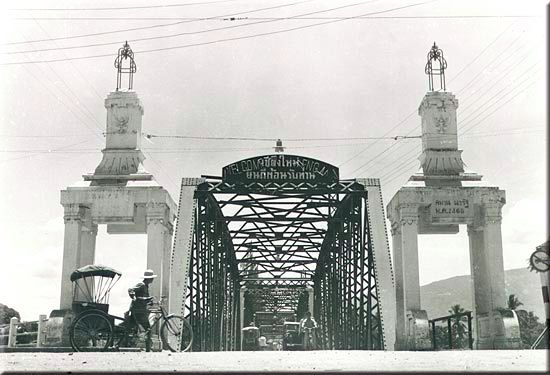
Abb.: Nawarat-Brücke (สะพานนวรัฐ) über den
Ping-Fluss (แม่น้ำปิง),
Chiang Mai (เชียงใหม่), ca. 1922
[Bildquelle: Anne & Heiner Damm. --
http://www.hdamm.de/afotos/ah_opidx.htm.
-- Zugriff am 2013-02-28. --
Creative Commons
Lizenz (Namensnennung, share alike)]
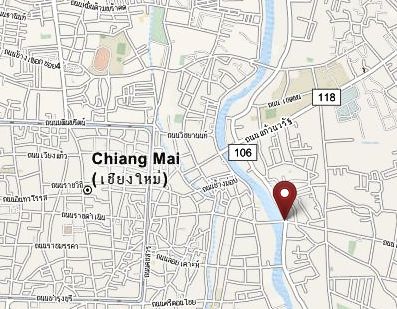
Abb.: Lage der Nawarat-Brücke (สะพานนวรัฐ)
[Bildquelle: OpenStreetMap. --
Creative
Commons Lizenz (Namensnennung, share alike)]
1922
Abb.: Paknam (ปากน้ำ), 1922
Abb.: Lage von Paknam (ปากน้ำ)
[Bildquelle: OpenStreetMap. -- Creative Commons Lizenz (Namensnennung, share alike)]
1922
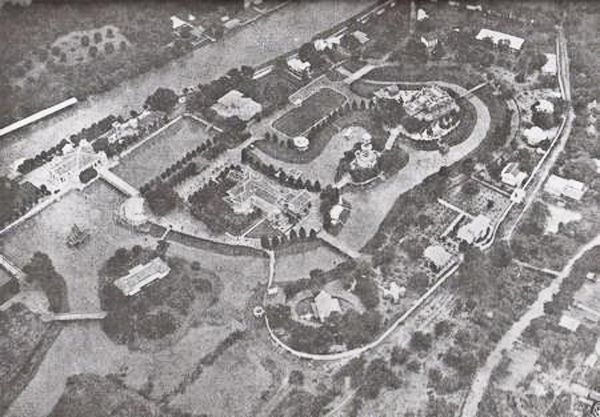
Abb.: Bang Pa In (บางปะอิน), 1922
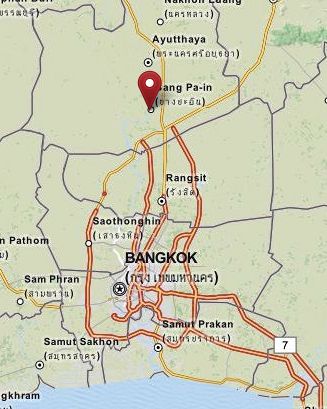
Abb.: Lage vonBang Pa In (บางปะอิน)
[Bildquelle: OpenStreetMap. --
Creative
Commons Lizenz (Namensnennung, share alike)]
1922
Abb.: Empire Hotel, Bangkok, Yaowarat Rd. (ถนนเยาวราช), 1922
Abb.: Lage der Yaowarat Rd. (ถนนเยาวราช)
[Bildquelle: OpenStreetMap. -- Creative Commons Lizenz (Namensnennung, share alike)]
1922

Es erscheint
Morgenthaler, Hans <1890 - 1928>: Zur Kenntnis der Geologie und der Erzlagerstätten von Hinterindien / von Hans Morgenthaler (Burgdorf). -- In: Eclogae Geologicae Helvetiae. -- 17 (1922-1923). -- Heft 1. -- S. 124 - 130. -- "Manuskript eingegangen am 19. Mai 1922"
1922

Der britische Lehrer Frank Kingsley Exell über Bangkok:
"Nothing could be more varied than the street scenes. If Bangkok was nothing less it was cosmopolitan. Its population represented a pretty good cross-section of Asia and Europe. If you had the energy to walk from one end of the New Road to the other, you would come across Burmese, Pathans, Malays, Cambodians, Peguans [Mon from Pagan], Laos, Japanese, Madrassees, Singalese, and of course, Chinese. Most of them dressed distinctively. There were the flowing robes of the Pathan, the sarong of the Malay, and panuang [ผ้านุ่ง] of the Siamese. And what greater contrast could you have had than the yellow robe of a Buddhist priest and the long black gown of his French Roman Catholic counterpart? It was a riot of colour, race and creed. And yet you did not sense any antagonism." [Zitiert in: Kamala Tiyavanich [กมลา ติยะวนิช] <1948 - >: The Buddha in the jungle. -- Chiang Mai : Silkworm, 2003. -- 380 S. ; Ill. ; 22 cm. -- ISBN 974-9575-27-X. -- S. 61. -- Faire use]
1922
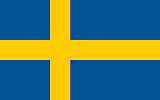
Die schwedischen Studenten Baltzar von Platen (1898–1984) und Carl Georg Munters (1897–1989) erfinden den Gas-Absorptionskühlschrank. Dieser benötigt zum Betrieb keiner Elektrizität.
1922

Der US-Landwirt Ralph Samuelson (1904 - 1977) macht die ersten Versuche mit Wasserski.
Abb.: Wasserski, Phuket (ภูเก็ต), 2011
[Bildquelle: Adeel Anwer. -- http://www.flickr.com/photos/30545082@N00/5646217926. -- Zugriff am 2013-09-29. -- Creative Commons Lizenz (Namensnennung, keine Bearbeitung)]
1922-04
The Record: Europäer uns Amerikaner besitzen in Siam 96.000 rai (154 km²) Grundeigentum. Die französischen katholischen Missionen besitzen davon 35.000 rai (56 km").
1922-04-03

Josef W. Stalin ( Иосиф Виссарионович Сталин), geborener Iosseb Bessarionis dse Dschughaschwili (იოსებ ბესარიონის ძე ჯუღაშვილი, 1878 - 1953) wird Generalsekretär (Генеральный секретарь) des Zentralkomitees der Kommunistischen Partei der (künftigen) Sowjetunion (Коммунистическая партия Советского Союза).
Abb.: Josef W. Stalin ( Иосиф Виссарионович Сталин), geborener Iosseb Bessarionis dse Dschughaschwili (იოსებ ბესარიონის ძე ჯუღაშვილი), 1918
[Bildquelle: Wikimedia. -- Public domain]
1922-04-16 - 1922-11-19

Exposition Coloniale Nationale de Marseille (Frankreich).
Abb.: Plakat
1922-05-02
Karikatur über die Sorgen eines polygamen Manns, in der Zeitung Sayam rat (สยามรัฐ):
Abb.: ภาพศิ้นเดึอน แสดงเมียที่ ๑ ถึงที ? ... "Ein Bild vom Monatsende zeigt Frau Nr. 1 bis Frau Nr. ?, die von ihrem Herrn die regelmäßige Bezahlung einfordern."
[Bildquelle: Barmé (2002), S. 125]
1922-06-20

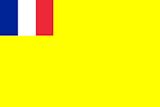
Der Kaiser des französischen Protektorats Annam, Khải Định (啟定, 1885 - 1925) ist auf Staatsbesuch in Paris (Frankreich).
Abb.: Kaiser Khải Định (啟定), 1916
[Bildquelle: Wikipedia. -- Public domain]
Abb.: Lage von Annam
[Bildquelle: Bearsmalaysia / Wikipedia. -- Creative Commons Lizenz (Namensnennung, share alike)]
1922-06-26

Eröffnung der Neilson Hays Library (ห้องสมุดเนียลสันเฮส์) in Bangkok in Erinnerung an die dänische Missionarin Jennie Neilson Hays (gest. 1920). Architekt: Mario Tamagno (1847 - 1941).
Abb.: Lage der Neilson Hays Library (ห้องสมุดเนียลสันเฮส์)
[Bildquelle: OpenStreetMap. -- Creative Commons Lizenz (Namensnennung, share alike)]
Abb.: Neilson Hays Library (ห้องสมุดเนียลสันเฮส์)
[Bildquelle: th.Wikipedia. -- Public domain]
Abb.: Neilson Hays Library (ห้องสมุดเนียลสันเฮส์), 2009
[Bildquelle: Radhapark Srilert. -- http://www.flickr.com/photos/8236395@N05/3410804750. -- Zugriff am 2013-09-03. -- Creative Commons Lizenz (Namensnennung, keine kommerzielle Nutzung)]
1922-07-10
Witz in der Filmzeitschrift Phaphayon Sayam (ภายนตร์สยาม, Siam Cinema) zu "Nation, Religion, König" (ชาติ, ศาสนา, พระมหากษัตริย์).
"Teacher: Students, I hope you can all remember what I told you about the duty of each and every young man. That duty is to give one’s unswerving loyalty to the Nation, the Religion, and the King. Now, I’d like to pose a question. Imagine enemy forces are attacking Paknam (ปากน้ำ). At this very moment I learn that someone is in my home fooling around with my wife. Class, tell me: what should I do?
The students rose to their feet as a group and, with a single voice, replied "Sir, go home."
Teacher: That’s right! That’s it! That’s exactly what I was thinking."
[Übersetzung: Barmé, Scot: Woman, man, Bangkok : love, sex, and popular culture in Thailand. -- Lanham : Rowman & Littlefield, 2002. -- 273 S. : Ill. ; 24 cm. -- ISBN 0-7425-0157-4. -- S. 1]
1922-07-11
Karikatur: normales Straßenleben und derselbe Ort, wenn die Vorbeifahrt von Mitgliedern des Königshauses erwartet wird (= diese sehen nie das Land, wie es wirklich ist), in der Zeitung Sayam rat (สยามรัฐ):
Abb.: oben: ถรรมดา (normalerweise) - unten: จะเสด็จ (es wird ein Prinz kommen)
[Bildquelle: Barmé (2002), S. 103]
1922-07-11
Karikatur über sexuelle Motive bei der Einstellung in Staatsdienst, im Periodikum Sayam sakkhi:
Abb.: Bittsteller: "Ich habe Abitur und möchte mich um eine Stelle bewerben." - Zettel des Beamten: "Ich habe keine Zeit." - Frau: "Ich habe meinen Bruder für eine Anstellung gebracht." -- Beamter: "Zugesagt!"
[Bildquelle: Barmé (2002), S. 120]
1922-07-20

Frankreich gibt allen Kriegsteilnehmern auf seiner Seite die Médaille Interalliée 1914–1918. Die für siamesische Weltkriegsteilnehmer (ca. 1500) ist von Prinz Itthithepsan Kritakara (อิทธิเทพสรรค์ กฤดากร 1890 - 1935) entworfen:
Abb.: Médaille Interalliée 1914–1918 (Siam)
[Bildquelle: Kwasura / Wikimedia. -- Public domain]
1922-08
Innenminister Chao Phraya Surasi (Choei Kanlayanamit) [มหาอำมาตย์เอก เจ้าพระยาสุรสีห์วิสิษฐศักดิ์ (เชย กัลยาณมิตร), 1863 - 1942] wird mit einer Jahrespension von 12.000 Baht in den Ruhestand entlassen. Prinz Boworadet (พระวรวงศ์เธอ พระองค์เจ้าบวรเดช, 1877 - 1953), Vizekönig des Nordens wird mit einer Jahrespension von 8.000 Baht pensioniert.
Abb.: Chao Phraya Surasi (Choei Kanlayanamit) [มหาอำมาตย์เอก เจ้าพระยาสุรสีห์วิสิษฐศักดิ์ (เชย กัลยาณมิตร)]
[Bildquelle: th.Wikipedia. -- Public domain]
1922-08
Temporary Provincial Administrative Code: der Innenminister erhält volle Autorität über alle Beamte in den Provinzen, die mit der inneren Verwaltung befasst sind.
1922-08
Phraya Phecharapani (Dan Raktaprachit) [พระยาเพชรปาณี (ดั่น รักตประจิต)] wird erster Oberbürgermeister (Lord Mayor - นายกเทศมนตรี) von Bangkok. Er war zuvor in einen Skandal verweickelt, bei dem 30.000 Baht, die ihm anvertraut waren, spurlos verschwunden sind. Seinen Oberbürgermeisterposten verdankt er seinen Beziehungen zu Chao Phraya Yomarat [เจ้าพระยายมราช (ปั้น สุขุม), 1862 - 1938].
1922-08-08


Der US Chargé d'Affaires an den Secretary of State über Chao Phraya Yomarat [เจ้าพระยายมราช (ปั้น สุขุม), 1862 - 1938] und Chao Phraya Ram Rakkhop [เจ้าพระยารามราฆพ (หม่อมหลวงเฟื้อ พึ่งบุญ)], die beiden Personen mit dem größten Einfluss auf Rama VI.:
"The two nobles have this been partners in the enterprise of influencing the government of the Kingdom . . . Yomarat furnishing the mental genius while the Lord Chamberlain [Ram Rakkhop] supplies the necessary access to the King. Singly, at other times, each had accomplished much in personal advancement; now, combined they have built up an organization difficult to overcome. Such circumstances, particularly in view of the fact that neither is of royal birth, has accordingly aligned them against the more prominent and able Royal Princes." [Zitiert in: Greene, Stephen Lyon Wakeman: Absolute dreams : Thai government under Rama VI, 1910-1925. -- Bangkok : White Lotus, 1999. -- 224 S. ; 22 cm. -- ISBN 974-8434-69-9. -- S. 151f.]
1922-08-09

Der britische Geschäftsträger, Lyle, an das Foreign Office über Finanzminister Kitiyakara Voralaksana, Prinz von Chanthaburi (พระเจ้าบรมวงศ์เธอ พระองค์เจ้ากิติยากรวรลักษณ์ กรมพระจันทบุรีนฤนาถ, 1874 - 1931):
"Prince Chandaburi was known to have declared that he would resume office on the I expiry of his leave, yet a month later I learnt from an important Siamese source that the Minister would not be found to have resumed his function at the end of August when his return was due, this latter decision being reputed to arise from an alleged demand of His Majesty that his civil list henceforward be twelve million ticals [baht] I instead of nine million as hitherto." [Zitiert in: Greene, Stephen Lyon Wakeman: Absolute dreams : Thai government under Rama VI, 1910-1925. -- Bangkok : White Lotus, 1999. -- 224 S. ; 22 cm. -- ISBN 974-8434-69-9. -- S. 154]
1922-08-12
Karikatur über den Weg vom Kind, für das die Bildung zu teuer ist, bis zum Dieb, in der Zeitung Sayam rat (สยามรัฐ):
Abb.: die Schule ist zu teuer - deswegen arbeitslos - deswegen ein Dieb, um überleben zu können
[Bildquelle: Barmé (2002), S. 106]
1922-08-22

Rama VI. verlautbart in der Bangkok Times, dass er die altehrwürdigen Sitte der königlichen Vielweiberei fortführen will:
"From consideration of state economy, the King will not make any public celebration of his marriage, but will instead follow the old and trusted custom of Siam." [Zitiert in: Greene, Stephen Lyon Wakeman: Absolute dreams : Thai government under Rama VI, 1910-1925. -- Bangkok : White Lotus, 1999. -- 224 S. ; 22 cm. -- ISBN 974-8434-69-9. -- S. 133]
Zu diesem Zweck fügt der König seinem Frauenbestand hinzu:
- Phraphai Sucharitkun (ประไพ สุจริตกุล, 1902 - 1975)
- Suwathana Aphaiwong (สุวัทนา อภัยวงศ์, 1906 - 1985)

His Majesty George V, by the Grace of God, of the United Kingdom of Great Britain and Ireland and of the British Dominions beyond the Seas, King, Defender of the Faith, Emperor of India zeigt wenig Verständnis für Rama VI. Traditionsbewusstsein:
"What an extraordinary state of affairs and after being educated at Oxford." [Zitiert in: Greene, Stephen Lyon Wakeman: Absolute dreams : Thai government under Rama VI, 1910-1925. -- Bangkok : White Lotus, 1999. -- 224 S. ; 22 cm. -- ISBN 974-8434-69-9. -- S. 133]
Abb.: Dominius illuminatio mea - Der HERR ist meine Erleuchtung
[Bildquelle: Wikimedia. -- ®]
1922-09


Sophia Belikovich, Tänzerin der Operntruppe Warschau (Polen) ist in Bangkok. Rama VI. nimmt bei ihr Tanzunterricht.
1922-10-10

Schaffung der Confederated Shan States
Abb.: Lage der Confederated Shan States (Karte von 1884)
"The Federated Shan States was the name given to an administrative division of the British Empire made up by the much larger Shan States and the Karenni States during British rule in Burma. The federation was established in order to facilitate the future transfer of the Shan principalities to the Governor of Burma. Unaware of the implications of the British political move, the Shan Saophas lost power in the process and had to contribute 50% of their revenue to the central fund as well. Their status was thus diminished from having been semi-sovereign rulers of princely states when the latter were established in 1888 to that of becoming a kind of tax collectors.[1]
HistoryUnder the British colonial administration, the former Shan States consisted of nominally sovereign entities, each ruled by a local monarch, but administered by a single British commissioner. On 10 October 1922 the administrations of the Karenni states and the Shan states were officially clustered together in order to establish the Federated Shan States,[2] under a British commissioner who also administered the Wa States.[3]
On 27 May 1942, during World War II, Kengtung State (ကျိုင်းတုံ) was invaded and its capital captured by the Imperial Japanese Army.[4] Following a previous agreement between Thai Prime Minister Plaek Phibunsongkhram (พิบูลสงคราม, 1897 - 1964) and the Japanese Empire, in December the same year the Thai Phayap Army (ทัพพายัพ) occupied the part of the Karenni states located between the Thai border and the Salween, corresponding to the eastern half of Kantarawadi State (กันตรวดี), as well as two districts of Mawkmai and four districts of Möngpan (မိုင်းပန်မြို့). The annexation by Thailand as Saharat Thai Doem (สหรัฐไทยเดิม) northern province was formalised on 1 August 1943.[5]
Following the existing agreement between Thai Prime Minister Plaek Phibunsongkhram (Phibun) and the Japanese Empire, on 18 August 1943, the Japanese government agreed to the Thai annexation of Kengtung and part of Mongpan state (as well as the annexation of Kelantan, Trengganu, Kedah, Perlis states and nearby islands in Malaya.)[6] The other districts that the Thai government wanted in the southern Shan states and the Karenni states, all located east of the Salween River, were assigned by the Japanese to their client State of Burma in September 1943.[7]
Thailand left the territory in 1945, but officially relinquished its claim over the territories of the Federated Shan States it had occupied only in 1946 as part of the condition for admission to the United Nations and the withdrawal of all wartime sanctions for having sided with the Axis powers.[8]
Post-independence BurmaWhen Burma gained independence in 1948, the Federated Shan States became Shan State and Kayah State of the Union of Burma with the right to secede from the Union. Following the 1962 Burmese coup d'état, the status of the Shan States and the saophas' hereditary rights were removed by Gen. Ne Win's (နေဝင်း, 1910 - 2002) military government."
[Quelle: https://en.wikipedia.org/wiki/Federated_Shan_States. -- Zugriff am 2016-04-29]
1922-10-22

Vier siamesiche Breguet fliegen nach Hanoi (Annam) um den Besuch französischer Flieger vom Juli 1921 zu erwidern. Die Piloten legen einen Kranz am Denkmal für die Gefallenen des Weltkriegs nieder.
Abb.: Strecke Bangkok - Hanoi
[Bildquelle: Bartholomew, J. G. <1860 - 1920>: A literary & historical atlas of Asia. -- London, o. J.]
Abb.: Siamesische Breguets in Hanoi, 1922-10-22
[Bildquelle: http://www.rtaf.mi.th/MUSEUM/RTAF%202453-2470En.pdf. -- Zugriff am 2013-11-18]
1922-10-23 - 1923-05-20

Andrew Bonar Law (1858 - 1923) ist Prime Minister Großbritanniens.
Abb.: Andrew Bonar Law / von Leslie Ward (1851 - 1922)
[Bildquelle: Vanity fair. -- 1905-03-02]
1922-11-01
Beginn des "Northern Express", eines Luxus-Zugs zwischen Bangkok und Chiang Mai (เชียงใหม่).
Abb.: Bahnlinie nach Chiang Mai (เชียงใหม่)
[Bildquelle: OpenStreetMap. -- Creative Commons Lizenz (Namensnennung, share alike)]
1922-11-20

Moskau: Gründung der Union der Sozialistischen Sowjetrepubliken (UdSSR, Союз Советских Социалистических Республик -- СССР)
Abb.: Karte des asiatischen Teils der Sowjetunion 1929
[Bildquelle: Wikimedia. -- Public domain]
1922-11-26

Premiere des ersten Farbfilms in Technicolor: The Toll of the Sea von Chester M. Franklin. Technicolor ist bis 1952 das wichtigste Verfahren für Farbfilme.
Abb.: Filmszene
[Bildquelle: Wikipedia. -- Public domain]
1922-11/ 1922-12
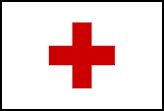
Bangkok: League of the Red Cross Societies, Far Eastern Conference: erster Kongress der Oriental Red Cross Societies. Gesundheitsausstellung auf königlichem Grund. 221.000 Bangkoker besuchen die Ausstellung, das sind ca. zwei Drittel der Bevölkerung Bangkoks.
1922-12-01

Trotz britischer Intervention zu seinen Gunsten, muss Finanzminister Kitiyakara Voralaksana, Prinz von Chanthaburi (พระเจ้าบรมวงศ์เธอ พระองค์เจ้ากิติยากรวรลักษณ์ กรมพระจันทบุรีนฤนาถ, 1874 - 1931) zurücktreten.
1922-12-01

Der schwarze Trompeter Louis Armstrong (1901 - 1971) begeistert Chicago (USA).
Abb.: Louis Armstrong, 1953
[Bildquelle: World-Telegram staff photographer / LoC / Wikimedia. -- Public domain9
1922-12-07

Rama VI. eröffnet feierlich das Queen Saovabha Memorial Institute (สถานเสาวภา สภากาชาดไทย).
Abb.: Queen Saovabha Memorial Institute (สถานเสาวภา สภากาชาดไทย), 2009
[Bildquelle: Paul_012. -- GFDLicense]
Abb.: Lage des Queen Saovabha Memorial Institute (สถานเสาวภา สภากาชาดไทย)
[Bildquelle: OpenStreetMap. -- Creative Commons Lizenz (Namensnennung, share alike)]
"Das Saovabha-Institut (thailändisch สถานเสาวภา สภากาชาดไทย, RTGS: Sathan Saowapha Sapha Kachat Thai, „Saovabha-Institut der thailändischen Rotkreuz-Gesellschaft“, englisch Queen Saovabha Memorial Institute, früher Pasteur-Institut Bangkok) ist ein Institut für Antisera und Impfstoffe am Sitz des Thailändischen Roten Kreuzes im Bangkoker Bezirk Pathum Wan [ปทุมวัน]. Es ist nach Königin Saovabha Phongsri (1864–1919), einer der Hauptfrauen von König Rama V. (Chulalongkorn), benannt. Angeschlossen ist eine Schlangenfarm zur Zucht von Giftschlangen und Entwicklung der entsprechenden Gegengifte." [Quelle: http://de.wikipedia.org/wiki/Saovabha-Institut. -- Zugriff am 2014-07-01]
"The Work of the Institute. The Scientific Section is divided into two main divisions, viz.,
- Department of Human Medicine.
- Department of Veterinary Medicine.
The Department of Human Medicine has the following work :—
- Prophylactic inoculation of anti-rabic vaccine. Inoculations were given to 7,063 patients from 1902 to 1929.
- Treatment of snake-bite with anti-venom serum; 3,058 cases were successfully treated from 1903 to 1929.
- Manufacture of small-pox vaccine for 2,000.000 people per annum.
- Manufacture of other vaccines and sera, viz., anti cholera, typhoid, plague, gonococcus vaccines etc.; anti-venom and anti-dysentery sera, etc. Over 400,000 doses of anti-cholera vaccine are prepared per year. A large quantity of anti-venom serum is also produced and distributed all over the country.
- Research work on pathogenic micro-organisms in view of diagnosis and treatment of diseases.
The Department of Veterinary Medicine has the following work :—
- Manufacture of various vaccines and sera for diseases of animals, e. g., a vaccine prophylactic for an epidemic disease of buffaloes, anthrax vaccine, anti-rabic vaccine, prophylactic vaccine for epidemic diseases of pigs and hens, etc. ; sera for treatment of epidemic diseases of buffaloes, anti-anthrax serum, etc. Not less than 70,000 doses of prophylactic vaccine for epidemic disease of buffaloes are produced yearly.
- Research work on pathogenic micro-organisms in view of diagnosis and treatment of diseases of animals.
- Assisting the Veterinary Division of the Ministry of Lands and Agriculture by examination of pathogenic microorganisms and diagnosis of diseases of animals throughout the country.
In the manufacture of vaccines and sera, prophylactic and therapeutic, both for men and animals, the Government has set up a Committee to superintend the production and distribution.
The Scientific Section of the Red Cross Society takes up research work in the pathology of human and animal diseases. The research work is stimulated to a certain extent by the two annual prizes, first and second, awarded through the Red Cross Society by the King and Queen respectively.
The Institute provides also practical courses in Microbiology for medical men and veterinarians.
Summary.
The Scientific Section of Siamese Red Cross Society - has the following work in hand :—
- Treatment of people bitten by mad dogs or snakes.
- Manufacture of vaccines and sera for the prophylaxis or treatment of human and animal diseases.
- Research on pathogenic bacteria with a view to obtain the etiology, diagnosis, prophylaxis or treatment of disease, human or animal.
- Keeping of poisonous snakes to obtain their venoms for the manufacture of serum ; keeping of animals employed in the manufacture of vaccines and sera, experiments and research work.
- As a centre of research work for all medical men and veterinarians, who may make use of the apparatus, literature, chemical reagents, etc. provided.
- As a centre of learning and practice in the medical sciences to medical men and veterinarians."
[Quelle: Siam : general and medical features / by the Executive Committee of the 8th Congress of Far Eastern Association of Tropical Medicine. -- Bangkok : Bangkok Times, 1930. -- 332 S. : Ill ; 25 cm. -- S. 269f.]
1922-12-19
Laut Bangkok Times kostet die Änderung des Familiennamens 20 Baht.
1922-12-19


Tagung: Monseigneur Pallegoix [1805 - 1862], sa vie, son oeuvre au Siam : conférence donnée le mardi 19, décembre 1922, au "Comité de l'Alliance française".
1922-12-23
Eröffnung der Sattahip Naval Base (ฐานทัพเรือสัตหีบ)
Abb.: Lage der Sattahip Naval Base (ฐานทัพเรือสัตหีบ)
[Bildquelle: OpenStreetMap. -- Creative Commons Lizenz (Namensnennung, share alike)]
Abb.: ®Batch 2013Sattahip Naval BaseSattahip Naval Base
1922-12-30

Bangkok: Unterzeichnung des treaty for the extradition of fugitives from justice zwischen Siam und den USA
"Article II
Persons shall be delivered up according to the provisions of the present Treaty, who shall have been charged with or convicted of any of the following crimes:
- Murder, comprehending the crimes designated by the terms parricide, assassination, manslaughter, when voluntary, poisoning, or infanticide.
- The attempt to commit murder.
- Rape, abortion, carnal knowledge of children under the age of twelve years.
- Abduction or detention of women or girls for immoral purposes.
- Bigamy.
- Arson.
- Willful and unlawful destruction or obstruction of railroads which endangers human life.
- Crimes committed at sea:
- Piracy, as commonly known and defined by the law of nations, or by statute;
- Wrongfully sinking or destroying a vessel at sea or attempting to do so;
- Mutiny or conspiracy by two or more members of the crew or other persons on board of a vessel on the high seas, for the purpose of rebelling against the authority of the Captain or Commander of such vessel, or by fraud or violence taking possession of such vessel;
- Assault on board ship upon the high seas with intent to do bodily harm.
- Burglary, defined to be the act of breaking into and entering the house of another in the night time with intent to commit a felony therein.
- The act of breaking into and entering the offices of the Government and public authorities, or the offices of banks, banking houses, savings banks, trust companies, insurance and other companies, or other buildings not dwellings with intent to commit a felony therein.
- Robbery, defined to be the act of feloniously and forcibly taking from the person of another goods or money by violence or by putting him in fear.
- Forgery or the utterance of forged papers.
- The forgery or falsification of the official acts of the Government or public authority, including Courts of Justice, or the uttering or fraudulent use of any of the same
- The fabrication of counterfeit money, whether coin or paper, counterfeit titles or coupons of public debt, created by National, State, Provincial, Territorial, Local or Municipal Governments, bank notes or other instruments of public credit, counterfeit seals, stamps, dies and marks of State or public administrations, and the utterance, circulation or fraudulent use of the above mentioned objects.
- Embezzlement or criminal malversation committed within the jurisdiction of one or the other party by public officers or depositaries, where the amount embezzled exceeds two hundred dollars or Siamese equivalent.
- Embezzlement by any person or persons hired, salaried or employed, to the detriment of their employers or principals, when the crime or offense is punishable by imprisonment or other corporal punishment by the laws of both countries, and where the amount embezzled exceeds two hundred dollars or Siamese equivalent
- Kidnapping of minors or adults, defined to be the abduction or detention of a person or persons, in order to exact money from them, their families, or any other person or persons, or for any other unlawful end.
- Larceny, defined to be the theft of effects, personal property, or money, of the value of twenty-five dollars or more, or Siamese equivalent
- Obtaining money, valuable securities or other property by false pretences or receiving any money, valuable securities or other property knowing the same to have been unlawfully obtained, where the amount of money or the value of the property so obtained or received exceeds two hundred dollars or Siamese equivalent
- Perjury or subornation of perjury.
- Fraud or breach of trust by a bailey, banker, agent, factor, trustee, executor, administrator, guardian, director or officer of any company or corporation, or by anyone in any fiduciary position, where the amount of money or the value of property misappropriated exceeds two hundred dollars or Siamese equivalent.
- Crimes and offenses against the laws of both countries for the suppression of slavery and slave trading.
- Willful desertion or willful non-support of minor or dependent children.
- Extradition shall also take place for participation in any of the crimes before mentioned as an accessory before or after the fact; provided such participation be punishable by imprisonment by the laws of both the High Contracting Parties."
1923-01-06
Mit dem Zug von Chiang Mai kommend trifft der britische Schriftsteller W. Somerset Maugham (1874 - 1965) in Bangkok ein und wohnt im Oriental Hotel.
Abb.: W. Sommerset Maugham
[Bildquelle: Wikipedia. -- Public domain]Während seines Bangkokaufenthalts erhält er eine Einladungskarte für einen Massagesalon (Bordell):
"Oh, gentleman, sir, Miss Pretty Girl welcome you Sultan Turkish Bath, gentle polite massage, put you in dreamland with perfume soap. Latest gramophone music. Oh, such service. You come now! Miss Pretty Girl want you, massage you from tippy-toe to head-top, nice, clean, to enter Gates of Heaven."
1923-01
Eröffnung der zweiten Luftpost-Linie Siams: Nakhon Ratchasima (นครราชสีมา) - Roi Et (ร้อยเอ็ด) - Udon Thani (อุดรธานี)
1923-01-23
Karikatur über hohe Personen (den König), in der Zeitung Sayam rat (สยามรัฐ):
Abb.: เงิน (Geld) - เย็นใจเสียก็ไถ้ (Seid unbesorgt, alles ist o. k.)
[Bildquelle: Barmé (2002), S. 104]
1923-02
Unruhen in Pattani (ปัตตานี / ڤتنا). Ein Türke nützt die Resentiments der Malayen gegen die Thais und bildet Guerilla-Einheiten. Polizei und örtliches Wild Tiger Corps sowie Royal Palace Guards aus Bangkok schlagen die Rebellion 1923-03 nieder.
Abb.: Lage von Pattani (ปัตตานี / ڤتنا)
[Bildquelle: OpenStreetMap. -- Creative Commons Lizenz (Namensnennung, share alike)]
1923-03

Der japanische General Ōshima Ken'ichi (大島 健一, 1858 - 1947) vor dem Oberhaus (貴族院) gegen die Kürzung des Wehretats um $24 Mio.:
"The height of folly is to imagine that the cutting of armaments would ensure peace. World peace is best maintained when nations are armed to the hilt! "
1923-03-10

Unterschrift unter den Freundschafts- und Handelsvertrag mit Japan. Ratifiziert 1924-03-22, tritt in Kraft 1924-12-29, gilt bis 1933-12-29
1923-03-14

Bangkok Times über die Stellungnahme Siams bei der 11. Internationalen Rot-Kreuz-Konferenz in Genf 1923 zur Bekämpfung des Opiums:
|
"Siam frankly told the Red Cross Conference that
she was not at present prepared to do more towards completing her avowed
policy in regard to that drug (opium).
[Abgedruckt in: Burslem, Chris: Tales of old Bangkok. -- Hong Kong : Earnshaw, 2012. -- ISBN 13-978-988-19984-2-2. -- S. 74] |
ausführlich: http://www.payer.de/thailandchronik/ressourcen.htm
Directory for Bangkok and Siam 1914. -- Bangkok : Bangkok Times, 1914. -- 380, 155 S. : Ill. ; 23 cm.
Vella, Walter F. <1924 - 1980>: Chayo! : King Vajiravudh and the development of Thai nationalism / Walter F. Vella, assisted by Dorothy B. Vella. -- Honolulu : Univ. Press, 1978. -- 347 S. : Ill. ; 25 cm. -- ISBN 0-8248-0493-7
Phongpaichit, Pasuk <ผาสุก พงษ์ไพจิตร, 1946 - > ; Baker, Chris <1948 - >: Thailand : economy and politics. -- Selangor : Oxford Univ. Pr., 1995. -- 449 S. ; 23 cm. -- ISBN 983-56-0024-4. -- Beste Geschichte des modernen Thailand.
Ingram, James C.: Economic change in Thailand 1850 - 1870. -- Stanford : Stanford Univ. Pr., 1971. -- 352 S. ; 23 cm. -- "A new edition of Economic change in Thailand since 1850 with two new chapters on developments since 1950". -- Grundlegend.
Akira, Suehiro [末廣昭] <1951 - >: Capital accumulation in Thailand 1855 - 1985. -- Tokyo : Centre for East Asian Cultural Studies, ©1989. -- 427 S. ; 23 cm. -- ISBN 4896561058. -- Grundlegend.
Skinner, William <1925 - 2008>: Chinese society in Thailand : an analytical history. -- Ithaca, NY : Cornell Univ. Press, 1957. -- 459 S. ; 24 cm. -- Grundlegend.
Mitchell, B. R. (Brian R.): International historical statistics : Africa and Asia. -- London : Macmillan, 1982. -- 761 S. ; 28 cm. -- ISBN 0-333-3163-0
Kludas, Arnold <1929 - >: Die Seeschiffe des Norddeutschen Lloyd 1857 bis 1970. -- Augsburg : Bechtermünz, 1998. -- 165 + 168 S. : Ill ; 28 cm. -- ISB 3-86047-262-3. -- Standardwerk.
Credner, Wilhelm <1892 - 1948>: Siam das Land der Tai : eine Landeskunde auf Grund eigner Reisen und Forschungen. -- Stuttgart : Engelhorn, 1935. -- 423 S. : Ill.
Bechert, Heinz <1932 - 2995>: Buddhismus, Staat und Gesellschaft in den Ländern des Theravāda-Buddhismus. -- Bd. 3: Bibliographie, Dokumente, Index. -- Wiesbaden : Harassowitz, ©1973. -- (Schriften des Instituts für Asienkunde in Hamburg ; XVII/3).
Barmé, Scot: Woman, man, Bangkok : love, sex, and popular culture in Thailand. -- Lanham : Rowman & Littlefield, 2002. -- 273 S. : Ill. ; 24 cm. -- ISBN 0-7425-0157-4
Zu Chronik B. E. 2466 / 1923-04 - 1924-03